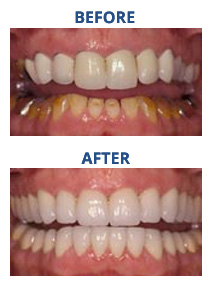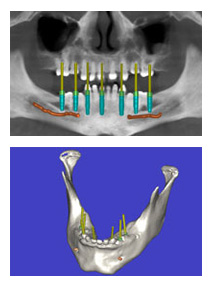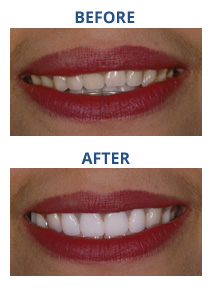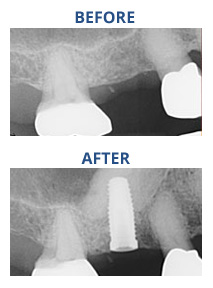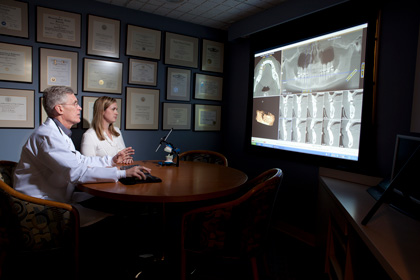Implant Dentistry

THE NEXT BEST THING TO NATURAL TEETH.
In the past, missing teeth often meant missing out on a certain level of function, comfort and freedom. But modern implant technology offers the next best thing to a second chance. These durable replacements are anchored into the jaw and look and function like natural teeth.
Dr. Pavinee has extensive experience and training in all procedures connected with implant therapy, including diagnosis, treatment planning, smile design, bone and soft tissue grafting, placement surgery, dental laboratory procedures, and final restorations. From initial consultation to follow-up visits, we offer you seamless care across the entire implant process, all from the convenience of a single office.
Implant Crowns
A dental implant topped with a crown is the closest replacement to a natural tooth. The implant itself is a small titanium post placed into the jawbone, taking the place of the missing tooth root. Once it has fully fused with the bone, a custom crown or bridge is attached for a secure, natural-looking result.
One major advantage of implant crowns is that they don’t affect the neighboring teeth. Plus, by replacing the root, the implant helps preserve the surrounding bone, preventing the bone loss that typically follows tooth loss.
Implant crowns are highly durable, resistant to decay and staining, and designed to look and function just like your natural teeth.
Implant Reconstructions
When patients are missing all teeth in one or both jaws but do not want removable appliances, permanent implant reconstructions are often possible. Treatment options depend on your overall oral health, and often include several different procedures.
Multiple implants placed in the jaw can support permanently cemented porcelain crowns or bridges. Sometimes all the teeth in the jaw can be replaced in this manner. When using this approach, it is important to be sure that there is adequate support for the lips and facial soft tissues, as this can vary from patient to patient. Some patients may have a high lip line, which could expose areas of gum and bone recession when they smile. But if the lip support, bone support and smile line allow implant supported porcelain bridges and crowns, they are the most natural-feeling and lifelike options.
When additional lip support is required, a hybrid bridge may be a better option. A hybrid bridge is screw-retained and is not removable by the patient. It can provide an acrylic flange to allow better lip support and mask areas of gum and bone recession.
Either of these options may also require additional planning and auxiliary procedures such as bone grafting, sinus lifts, CT scans and surgical guides. These all help to ensure more precise implant positioning and better support, and are especially useful when normal “landmarks” are missing (e.g., the natural positions of teeth).
As prosthodontists, Dr. Pavinee and Dr. Alvarado are also trained in complex care management, which may include multiple dental specialists, outside medical treatment and advanced dental laboratory services. We supervise every aspect of the process very carefully to ensure the results meet our exacting standards.
Immediate Restoration
Immediate Restoration allows patients with missing teeth or dentures to get dental implants and natural-looking replacement teeth in just one office visit. You may have seen news stories or ads about Teeth-in-a-Day® or Teeth-in-an-Hour®, and thought they sounded too good to be true.
These trademarked names, describing an accelerated surgical and restorative protocol, are more commonly called Immediate Restoration. Below are the requirements for Immediate Restoration and a brief description of how this procedure came about.
The original protocol for dental implants required a six-month period of undisturbed healing before teeth replacements were attached to the implants. The reason for this protocol is that dental implants will fail if they are allowed to move before bonding to the bone (called osseointegration) is complete. During the six-month healing period, patients would usually wear dentures or other types of removable dental appliances that were not attached to the implants.
Practitioners were reluctant to alter the six-month healing protocol because it was almost 100 percent successful. However, patients wanted faster results, and this spurred additional research. Further studies showed that if implants were placed in very solid bone, or if multiple implants were splinted together, the implants would remain stable enough to allow osseointegration with nearly the same success rate.
Extensive planning is required, and approaches may vary for each patient; however, the following key elements are integral components of Immediate Restoration:
- i-CAT CT scanning and 3-D imaging allow for extremely precise dental treatment planning; thus, ensuring implants are placed in exact locations and in areas of dense bone.
- Provisional tooth restorations are made before the patient’s appointment.
- In a single appointment, old dentures or failing teeth are removed, several implants are placed evenly around the jaw, and a connected arch of non-removable temporary teeth is attached to the implants.
- The provisional teeth restorations remain until osseointegration is complete. With this technique, implants remain stable because they are splinted together, and patients are thrilled that they can avoid a removable denture. Immediate Restoration can also be used for single implants when a CT scan shows that the patient’s bone is very dense.
- Permanent tooth restorations are placed once osseointegration is complete.
Immediate Restoration gives patients a new set of teeth that cannot slip, shift, or fall out, and it allows patients the freedom to eat, speak and smile with confidence. Results are immediate, so patients don’t have to worry about taking time off work or “laying low” while the restorations are being made. Drs. Pavinee and Alvarado have mastered this procedure and can give new hope to denture wearers who want a strong, healthy and beautiful smile, all in one visit.
Implant-Supported Dentures
Implant supported dentures (also called overdentures) are another option for patients who are missing multiple teeth. They are secured by two or more implants and are very different from the traditional dentures your parents or grandparents may have worn, which required adhesives to keep them in place.
Overdentures are full or partial dentures that are designed to attach to dental implants, so they can be snapped in for a secure fit and snapped out for easy cleaning and care. Benefits not found in traditional dentures include improved support, stability, retention and tactile sensation, as well as less bone loss when compared to conventional dentures. Your chewing strength can even increase by up to 300 percent.
The design of an overdenture will depend on the number of implants supporting it. With two implants (usually placed in the positions of the canine teeth), overdentures will likely have the same design as conventional dentures. But when more implants are used and connected with a bar, the denture flanges can be reduced and the palate of an upper denture can be removed. This allows better sensation of food and a less cumbersome feel.
As prosthodontists, Dr. Pavinee and Dr. Alvarado have extensive training and experience in all aspects of dentures and implant dentistry, which allow them to create natural-looking, precision-fit, implant-supported dentures and partials.
Bone Grafts
Bone grafting is a surgical procedure needed when there isn’t enough bone to support a dental implant. Since an implant is directly anchored into the jawbone, having sufficient bone volume is crucial. Bone grafting can essentially “build” the bone, increasing both its height and thickness, to create a more secure base for the implant.
Bone grafting can be done at the same time as your implant surgery or up to six months before, depending on your unique situation.
Where does the bone come from? The graft material may be taken from other areas of your mouth, or it may be sourced from human, animal, or synthetic materials obtained from a tissue bank. These materials are carefully sterilized, non-living, acellular, and free from antigenic properties, which means there’s no risk of disease transmission or rejection.
For patients with inadequate bone density, bone grafting significantly improves the success rate of an implant restoration. Drs. Pavinee and Alvarado have extensive expertise in this procedure, and they will review all your options, as well as the risks and benefits, to help you make the best decision.
Sinus Lifts
The human skull contains several air-filled spaces called sinuses, which are connected to the nasal passages. While their exact function remains unclear, it’s believed that they evolved to lighten the head, making it easier for the neck to support.
One of these sinuses, the maxillary sinus, is located in the upper jaw just above the molar and bicuspid teeth. In some cases, this sinus can become enlarged, thinning the bone in the area, which may not provide enough support for a dental implant.
A sinus lift (also called sinus elevation) is a bone-grafting procedure that increases the bone volume beneath the maxillary sinus. This is sometimes necessary for patients who don’t have enough bone in their upper posterior jaw to properly support a dental implant.
There are two types of sinus lift procedures. One type, called an osteotome sinus lift, involves a small instrument to push the floor of the sinus upward through the hole made for the dental implant. This technique is minimally invasive and is used when very little elevation is necessary. The other type, called a window sinus lift, requires an oval window in the bone lateral to the sinus. The soft tissue lining of the sinus, known as the sinus membrane, is carefully lifted and bone-grafting material is placed under it to provide support for a dental implant. A resorbable collagen barrier membrane is then placed over the window before closing and suturing the gum tissue.
Bone-grafting materials may be harvested from other areas of your mouth or obtained from a tissue bank (see bone grafts). No matter the source or technique used, the graft material will mature and develop into solid bone, providing a strong base for the dental implant.
Sinus lifts are safe and effective, and Drs. Pavinee and Alvarado perform them routinely on patients as part of total implant and reconstructive plans.
CT Scans and Planning
Successful implant dentistry demands a high level of precision, which is why we use computed tomography (CT) to create a 3D model of your mouth. This advanced technology allows us to pinpoint the ideal placement for your implants, ensuring optimal comfort and aesthetic results.
Additionally, it helps streamline the treatment process, reducing the time needed for implant restoration.
To help you visualize your implant procedure and end result, we will create a multimedia presentation to use when discussing your case and treatment options. This way, we can show you what we have in mind while we explain it.
We have found this type of presentation goes a long way toward helping patients fully understand their options, as well as the advantages and disadvantages of each procedure.
FAQ
Anyone who has missing teeth could potentially benefit from implants, either alone or as anchors for a bridge or dentures. Implants are often used as part of an overall dental restoration plan.
Historically, dental implants were made using various shapes, techniques and materials, but success rates for early methods were unimpressive. Most implants today are made of titanium. Research eventually led to the use of titanium because of its amazing characteristics. Titanium is a very strong yet inert metal that is not rejected by the body and to which bone will actually adhere (a process called osseointegration). Research has also shown that root-form implants, which are roughly the shape of a single tooth root, had the fewest problems — with success rates between 95 to 100 percent. Implant sizes may vary, depending on the volume of bone that is present, but most practitioners today use titanium root-form implants because of their proven success.
Compared to removable dentures, yes. However, insurance may cover part of the cost of the implant procedure, and most patients feel that the benefits of implants outweigh the costs.
Protocols for treatment vary depending on the circumstances of each case. In the best case scenario, tooth extraction, implant placement and restoration can all be completed during the same appointment. This procedure is called Teeth-in-a-Day®. Most commonly, if the bone is strong, it will take between four to six months from the implant placement surgery to the final restoration. When foundation structures are inadequate or unhealthy, a bone graft may be required prior to implant surgery. In these cases, restorations could be delayed one year from the beginning of treatment. During that time, you may be fitted with temporary replacement teeth.
Local anesthetics are used to be sure that you feel nothing during the procedure, and afterwards, you will be prescribed analgesics. Most patients are amazed at how easy the procedure was for them and how little discomfort they experienced. Nevertheless, placing an implant is a complex procedure, which can elicit fear and anxiety in some patients. You can rest assured that we use calming medications, as necessary, and take every precaution to ensure that you are relaxed and comfortable before, during and after your surgery.
Generally, we recommend you take it easy for one day after surgery, which means rest and avoiding strenuous activity. You may be feeling the effects of medications we prescribe, and strenuous activities after surgery can cause bleeding, swelling or bruising. The exact amount of time off required is an individual decision.
The longer teeth are missing, the worse the spiral becomes, and the more expensive and difficult it becomes to replace them. Tooth loss is a serious condition that should be taken seriously — and treated early — before these side effects occur.
No. Unlike a live soft tissue transplant, implants are made of surgical titanium, an inert metal, and are not rejected by the body. This doesn’t mean that an implant can’t fail due to infection, movement or injury, but there have been no reported cases of titanium rejection or allergy.
The dentist you choose should be properly trained to diagnose and place implants. One way to ensure this is to verify that they are accredited by the American Academy of Implant Dentistry. You can verify membership through the AAID website.

